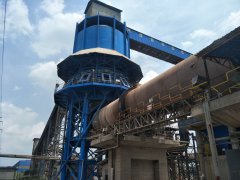A lime rotary kiln is a type of rotary kiln used for the production of quicklime by the calcination of limestone (calcium carbonate). The chemical equation for this process is:
\[ \text{CaCO}_3 \rightarrow \text{CaO} + \text{CO}_2 \]
In simple terms, limestone (CaCO₃) is heated in the lime kiln to produce quicklime (CaO) and carbon dioxide (CO₂). The lime rotary kiln plays a crucial role in various industries, particularly in the production of lime, which is used in applications such as construction, agriculture, water treatment, and more.
1. Raw Material: The primary raw material processed in a lime rotary kiln is limestone (CaCO₃). The quality and characteristics of the limestone influence the properties of the resulting quicklime.
2. High Temperatures: Lime rotary kilns operate at high temperatures, typically above 900 degrees Celsius (1,650 degrees Fahrenheit). The elevated temperatures are necessary for the calcination process to convert limestone into quicklime.
3. Rotary Structure: Similar to other rotary kilns, a lime rotary kiln has a cylindrical structure that rotates on its axis. The rotation ensures a consistent and controlled heating of the limestone throughout its length.
4. Heat Source: The heat required for the calcination process is provided by a direct flame or hot gases produced by burning fuels such as coal, natural gas, or oil. The heat source is directed into the kiln to raise the temperature of the limestone.
5. Controlled Environment: The rotary kiln provides a controlled environment for the calcination process. The controlled rotation and temperature distribution inside the kiln are essential for achieving uniform conversion of limestone into quicklime.
6. Refractory Lining: The interior of the lime rotary kiln is lined with refractory materials to withstand the high temperatures and chemical reactions occurring during the calcination process.
7. Product Handling: The quicklime produced in the lime kiln is discharged from the kiln and may undergo further processing, such as cooling and hydration, depending on the intended application.
Lime rotary kilns are widely used in the production of quicklime for applications such as soil stabilization, water treatment, steel manufacturing, sugar refining, and various construction activities. The versatility and efficiency of lime rotary kilns make them essential in industries that require high-quality lime products.



